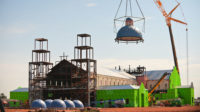Numbers Game
From 2002 through 2008, Southland's annual revenue jumped to $471 million from $222 million, largely because of its government work, according to the company. Though revenue has dipped in recent years because of the recession, it has remained at more than $400 million a year. The company's net worth is roughly $65 million. It employs 1,600 people.
"We were very fortunate going into the recession that we had a huge backlog, a lot of it federal work," says Lynch. "We had a lot of BRAC (Base Realignment and Closure) projects, and that carried us through the tough years, which were also some of our best years." BRAC was created by the U.S. Congress in 1990 to help the Dept. of Defense cut costs by closing unnecessary military bases and redeveloping others to create more sustainable facilities.
Lynch says he doesn't know yet how the recent federal budget cuts will affect Southland's government work. One of Southland's recent BRAC jobs—the $826-million, LEED-Gold Walter Reed National Military Medical Center in Bethesda, Md., was completed in 2012. One of the country's largest military hospitals, the new medical center arose from the merger of the National Naval Medical Center and the venerable Walter Reed Army Medical Center.
In addition to federal work, Southland specializes in mission-critical, education, hospitality and health care projects—from work on several California schools such as the Chabot and Las Positas community colleges to Las Vegas' M Resort and Aria Resort & Casino. "We're seeing a better balance now between private and public projects," Lynch says.
The contractor's business focuses on four main geographic areas—Northern Virginia, Northern and Southern California, and the Southwest. In addition to its Garden Grove campus, Southland operates offices in Dulles, Va.; Baltimore; Union City, Calif.; and Las Vegas.
Both Lynch and McLaughlin are based in the Dulles office. Southland's new LEED-Gold Garden Grove headquarters showcases the company's commitment to sustainable architecture and engineering. It features four HVAC systems—displacement ventilation, fan-powered induction units, chilled beams and a heat pump—as well as environmentally friendly piping, low-flow plumbing fixtures and daylighting.
While Southland has been known for its design-build work, Lynch wants to evolve the company from a contractor-centric design-builder to a company that can stand on its own as an engineering consulting firm, a construction firm and a service and energy-services firm. "We've taken our business from one size fits all to focusing on separate services," he says. "So I'm trying to flatten the organization out. We're being a little more creative in how we run our business." That flattening includes the recent launch of an energy-services operation.
As forward thinking as Lynch is, he still holds a traditional value that serves him and Southland well. He is a company man, having worked for Southland while he was in college and since he graduated, in a time when that's more and more rare. "Over the last 20 years, I've really gotten to know the company from the ground up. I've probably worked in every part of it," Lynch says. "I know its potential … so I'm stretching it and trying new things."


